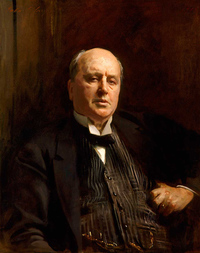An old friend of The Library of America is in New York City for the summer, receiving visitors by the hundreds every day and looking remarkably sharp despite having survived a brush with vandalism and, more recently, commemorated a hundredth birthday.

The “friend” in this case is the celebrated 1913 portrait of Henry James by John Singer Sargent—one of many arresting works featured in the exhibition Sargent: Portraits of Artists and Friends, currently on view at the Metropolitan Museum of Art. If the painting looks familiar to Library of America readers, that’s because it graces the dust jacket of the LOA volume Henry James: Complete Stories 1898–1910.
The Met’s exhibition is an opportunity to appreciate both Sargent’s artistic gifts and the remarkably rarefied nature of his social circle. His portraits encompass other painters, actors, singers, dancers, and of course writers, with Robert Louis Stevenson and W.B. Yeats both being caught especially vividly.
Sargent and James became friends after James published an extensive appreciation of the artist’s work in Harper’s magazine in 1887, where he wrote: “In an altogether exceptional degree does he give us the sense that an intention and the art of carrying it out are for him one and the same thing.” Their common experience as American expatriates and members of the cultural elite created a bond between the two men, but today it’s virtually a .jpg” target=”_blank”>regularly appear on the covers of James paperbacks.)
The 1913 portrait was a commission by James’s friends and admirers for his seventieth birthday. According to the exhibition catalogue, the author was happy with the result, calling it “Sargent at his very best and poor old HJ not at his worst; in short a living breathing likeness and a masterpiece of painting.”
But the “living breathing likeness” almost breathed its last before most people had a chance to see it for themselves. When the painting went on view at London’s Royal Academy in May 1914, a suffragette named Mary Wood attacked it with a meat cleaver, managing to slash the canvas three times before being apprehended. While it is tempting to speculate that Wood was venting her disapproval of the way James had portrayed the women’s movement in his novel The Bostonians nearly 30 years earlier, she was in fact engaged in a more general protest at the lack of political representation for women. In the years just prior to World War I, several English suffragettes drew attention to their cause by vandalizing pieces of art, and one theory about the Mary Wood incident suggests that at the time of its unveiling Sargent’s portrait would have symbolized an artistic elite that consisted entirely of men. (The Royal Academy itself was widely understood to be a “bastion of conservatism.”)
James relayed his feelings about the incident in a letter to his friend Jessie Allen:
Yes, it was a nasty one, or rather a nasty three—for she got at me thrice over before the tomahawk was stayed. I naturally feel very scalped and disfigured, but you will be glad to know that I seem to be pronounced curable—to all probability, that is, when the experts have well looked into me. The damage, in other words, isn’t past praying for, or rather past mending, given the magic of the modern mender’s art.
James’s optimism was well-founded. Sargent was quickly able to repair the painting with the help of a team of restorers, and The Library of America can attest that today “old HJ” looks none the worse for his ordeal.
Sargent: Portraits of Artists and Friends is on view at the Metropolitan Museum of Art in New York City through October 4, 2015. Visit metmuseum.org for complete exhibition information.



